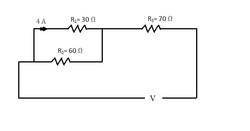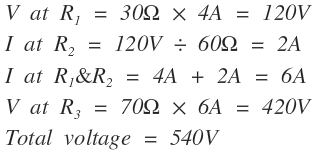Electric Circuit - 1
In the circuit shown, the current through R 1 is 4 amperes.
What is the value of V in volts?

This section requires Javascript.
You are seeing this because something didn't load right. We suggest you, (a) try
refreshing the page, (b) enabling javascript if it is disabled on your browser and,
finally, (c)
loading the
non-javascript version of this page
. We're sorry about the hassle.
7 solutions
Or just calculate total R and find bigger number and that is your answer
This is how I did it...
@Fahim Shahriar Shakkhor your's is definitely easier but just see how a I did it.
I 'll get through this problem with some other approach.
First of all the total R = 9 0 .
For those who want to know how :
As R 1 and R 2 are parallel so R p 1 = R 1 1 + R 2 1 where R p is the net resistance of the parallel circuits, it comes out to be, R p = 2 0 and its seen that R 3 = 7 0 and hence we arrive at the total R .
The current flowing through the wire I Now, the current in a parallel circuit get divided in the ratio of the individual resistances, i.e.. in R 1 the current flow 'd be 9 0 6 0 × I and in R 2 the current flow'd be 9 0 3 0 × I , In R 1 it is given 4 so plugging the values in, we get,
Note : That the current flow in R 1 is more than in R 2 because R 1 ⪇ R 2 and this is given by the ratios.
I = 6
V = I R ....and.. V = 5 4 0
This is what I DID! Cool! :D
how come R1 and R2 are in parallel ??
Log in to reply
Simply putting,they r parallel becoz current has got two ways to move...in other words, both the resistors have a common point
R1 and R2 are known to be in parallel because nodes exist before and after them in the circuit.
Let the currents through R 1 , R 2 and R 3 be I 1 , I 2 and I 3 respectively, voltage across R 1 and R 2 be V 1 and that across R 3 be V 2 .
Then we have:
I 1 = 4 A ⇒ V 1 = I 1 R 1 = 4 × 3 0 = 1 2 0 V
I 2 = R 2 V 1 = 6 0 1 2 0 = 2 A
⇒ I 3 = I 1 + I 2 = 4 + 2 = 6 A ⇒ V 2 = I 3 R 3 = 6 × 7 0 = 4 2 0 V
⇒ V = V 1 + V 2 = 1 2 0 + 4 2 0 = 5 4 0 V
It is given that current through R1(30 ohm) is 4A, hence current through R2 (60 ohm) must be half of current through R1 .Hence current through R2 is 2A. So net current supplied by battery is equal to 6A.
NOW parallel combination of R1 and R2 is in series with R3, hence equivalent resistance of given circuit is equal to 90 ohm. applying ohm's law;
V=IR; V=net current supplied by battery* equivalent resistance .
V=6*90=540 ohm.
potential difference of R1 or R2 is = 30 ohm * 4A = 120V . But the equivalent resistance of R1 & R2 , is Rp = 1/(1/30 + 1/60) ohm = 20 ohm. So, the current flowing through the series connection of Rp & R3 is = 120V/20ohm = 6A . But the equivalent resistance of the whole circuit is = Rp + R3 = 70 ohm + 20 ohm = 90 ohm. So the Voltage in this circuit is = 90ohm * 6A = 540V.

Since R 1 and R 2 are in parallel,
V 1 = V 2 ⇒ I 1 R 1 = I 2 R 2 ⇒ 4 A × 3 0 Ω = I 2 × 6 0 Ω ⇒ I 2 = 2 A
From Kirchoff's First Law, I 3 = I 1 + I 2 = 4 A + 2 A = 6 A
V 3 = I 3 R 3 = 6 A × 7 0 Ω = 4 2 0 V
Now, V = V 1 + V 3 = 1 2 0 V + 4 2 0 V = 5 4 0 V